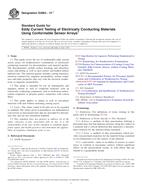Potřebujeme váš souhlas k využití jednotlivých dat, aby se vám mimo jiné mohly ukazovat informace týkající se vašich zájmů. Souhlas udělíte kliknutím na tlačítko „OK“.
ASTM E2884-13e1
Standard Guide for Eddy Current Testing of Electrically Conducting Materials Using Conformable Sensor Arrays (Includes all amendments And changes 12/19/2017).
Automaticky přeložený název:
Standardní příručka pro zkoušení vířivými proudy z elektricky vodivého materiálů pomocí přizpůsobitelné senzorových polí
NORMA vydána dne 1.6.2013
Informace o normě:
Označení normy: ASTM E2884-13e1
Poznámka: NEPLATNÁ
Datum vydání normy: 1.6.2013
Kód zboží: NS-46199
Počet stran: 7
Přibližná hmotnost: 21 g (0.05 liber)
Země: Americká technická norma
Kategorie: Technické normy ASTM
Kategorie - podobné normy:
Měření elektrických a magnetických veličin
Nedestruktivní zkoušení
Anotace textu normy ASTM E2884-13e1 :
Keywords:
conformable sensor array, corrosion, eddy current, material loss, material thickness, nondestructive testing, stress corrosion cracking, ICS Number Code 17.220.20 (Measurement of electrical and magnetic quantities), 19.100 (Non-destructive testing)
Doplňující informace
| Significance and Use | ||||||||||||||
|
5.1 Eddy current methods are used for nondestructively locating and characterizing discontinuities in magnetic or nonmagnetic electrically conducting materials. Conformable eddy current sensor arrays permit examination of planar and non-planar materials but usually require suitable fixtures to hold the sensor array near the surface of the material of interest, such as a layer of foam behind the sensor array along with a rigid support structure. 5.2 In operation, the sensor arrays are standardized with measurements in air and/or a reference part. Responses measured from the sensor array may be converted into physical property values, such as lift-off, electrical conductivity, and/or magnetic permeability. Proper instrument operation is verified by ensuring that these measurement responses or property values are within a prescribed range. Performance verification on reference standards with known discontinuities is performed periodically. 5.3 The sensor array dimensions, including the size and number of sense elements, and the operating frequency are selected based on the type of examination being performed. The depth of penetration of eddy currents into the material under examination depends upon the frequency of the signal, the electrical conductivity and magnetic permeability of the material, and some dimensions of the sensor array. The depth of penetration is equal to the conventional skin depth at high frequencies but is also related to the sensor array dimensions at low frequencies, such as the size of the drive winding and the gap distance between the drive winding and sense element array. For surface-breaking discontinuities on the surface adjacent to the sensor array, high frequencies should be used where the penetration depth is less than the thickness of the material under examination. For subsurface discontinuities or wall thickness measurements, lower frequencies and larger sensor dimensions should be used so that the depth of penetration is comparable to the material thickness. 5.4 Insulating layers or coatings may be present between the sensor array and the surface of the electrically conducting material under examination. The sensitivity of a measurement to a discontinuity generally decreases as the coating thickness and/or lift-off increases. For eddy current sensor arrays having a linear drive conductor and a linear array of sense elements, the spacing between the drive conductor and the array of sense elements should be smaller than or comparable to the thickness of the insulating coating. For other array formats the depth of sensitivity should be verified empirically. 5.5 Models for the sensor response may be used to convert responses measured from the sensor array into physical property values, such as lift-off, electrical conductivity, magnetic permeability, coating thickness, and/or substrate thickness. For determining two property values, one operational frequency can be used. For nonmagnetic materials and examination for crack-like discontinuities, the lift-off and electrical conductivity should be determined. For magnetic materials, when the electrical conductivity can be measured or assumed constant, then the lift-off and magnetic permeability should be determined. The thickness can only be determined if a sufficiently low excitation frequency is used where the depth of sensitivity is greater than the material thickness of interest. For determining more than two property values, measurements at operating conditions having at least two depths of penetration should be used; these different depths of penetration can be achieved by using multiple operational frequencies or multiple spatial wavelengths. 5.6 Processing of the measurement response or property value data may be performed to highlight the presence of discontinuities, to reduce background noise, and to characterize detected discontinuities. As an example, a correlation filter can be applied in which a reference signature response for a discontinuity is compared to the measured responses for each sensor array element to highlight discontinuity-like defects. Care must be taken to properly account for the effect of interferences such as edges and coatings on such signatures. |
||||||||||||||
| 1. Scope | ||||||||||||||
|
1.1 This guide covers the use of conformable eddy current sensor arrays for nondestructive examination of electrically conducting materials for discontinuities and material quality. The discontinuities include surface breaking and subsurface cracks and pitting as well as near-surface and hidden-surface material loss. The material quality includes coating thickness, electrical conductivity, magnetic permeability, surface roughness and other properties that vary with the electrical conductivity or magnetic permeability. 1.2 This guide is intended for use on nonmagnetic and magnetic metals as well as composite materials with an electrically conducting component, such as reinforced carbon-carbon composite or polymer matrix composites with carbon fibers. 1.3 This guide applies to planar as well as non-planar materials with and without insulating coating layers. 1.4 Units—The values stated in SI units are to be regarded as standard. The values given in parentheses are mathematical conversions to inch-pound units that are provided for information only and are not considered standard. 1.5 This standard does not purport to address all of the safety concerns, if any, associated with its use. It is the responsibility of the user of this standard to establish appropriate safety and health practices and determine the applicability of regulatory limitations prior to use. |
||||||||||||||
| 2. Referenced Documents | ||||||||||||||
|




 Cookies
Cookies
